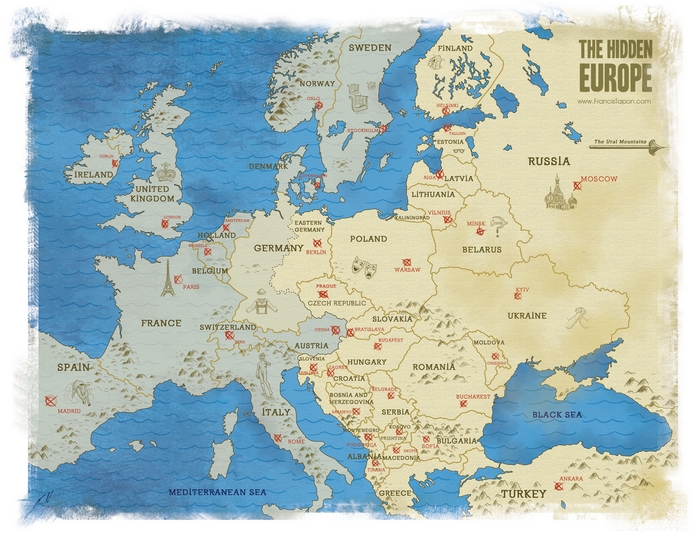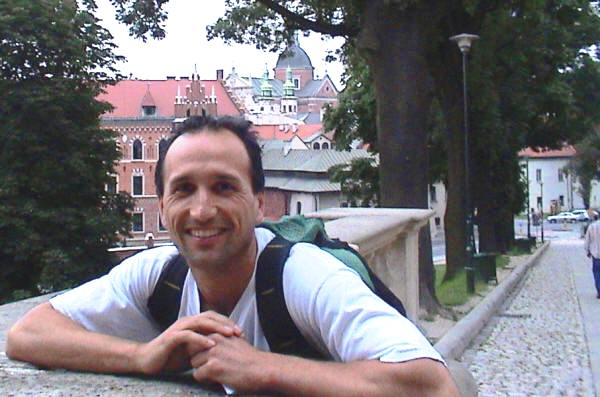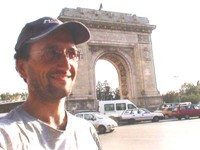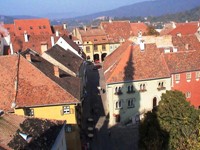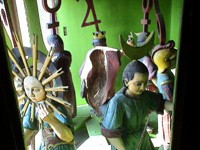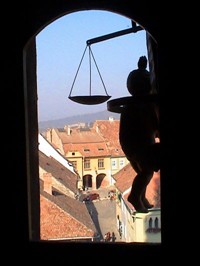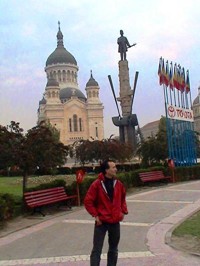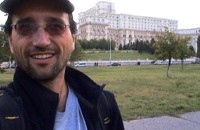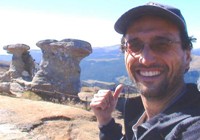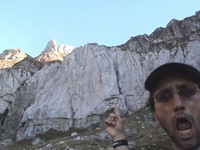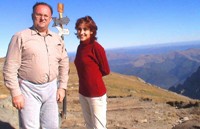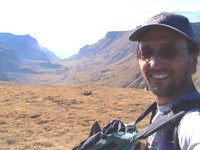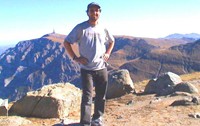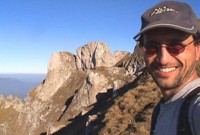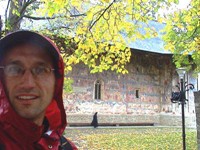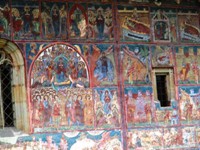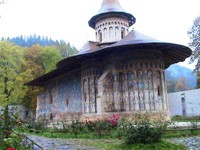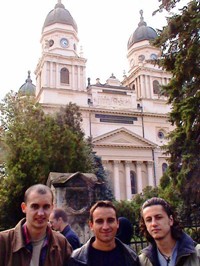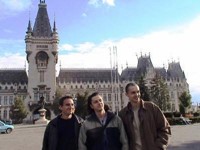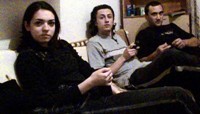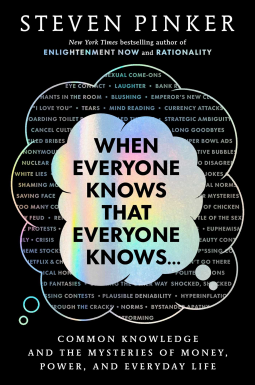Eastern Europe
Exploring the Hidden Europe in 2004 and 2008-2011
In 2004, I visited all 25 countries in Eastern Europe. You'll find the blog entries from that trip here. In 2008-2011, I returned to see what had changed since that time. With these two visits, five years apart, I accumulated enough material for my 750-page book, The Hidden Europe: What Eastern Europeans Can Teach Us.
This blog now has many excerpts from The Hidden Europe. But who the hell reads anymore? Just look at the best photos from Eastern Europe!
This map reflects how I define Eastern Europe. Eastern Europeans love to deny that they're in Eastern Europe. I tackle how and why I define Eastern Europe the way I do in the Introduction of The Hidden Europe.
I wrote this article in 2004. I celebrated my birthday here five years later because it's my favorite place in Eastern Europe.
Captivating Kotor
I can think of no higher compliment I can pay a town than to say, "I want to buy a house here."
That's what I said when I walked through the streets of Kotor, Montenegro.
From an interior with Alpine-type scenery to deep canyons, coastal fjords, and a sparsely vegetated and limestone mountain range that plummets down to an azure Adriatic sea, Montenegro has got the works. But it was Kotor, a town which lies in the largest fjord in southern Europe, that stole my heart.
The highlight of my Eastern European trip: Kotor
My guidebook says, "Kotor is a big secret." No kidding.
Kotor is a small town with a population of 25,000, and it lies on the Montenegrin coast in the southern Adriatic. It stands at the foot of the Lovcen massif, at the end of the deep, rugged Bay of Kotor.
Tiny Kotor has all the features I love in a typical Venetian town: narrow sinuous streets, little picturesque shops, antique monuments, and enchanting plazas. But it has something that Venice and Dubrovnik don't: massive mountains towering all around the city which is set at the end of a triple bays. And it's a lot cheaper too!
It's got a cool location. OK, so Kotor doesn't have the canals of Venice, but maybe global warming will change that.
Plus, you have the thrill of knowing that the Serbs might want to invade at any moment.
Kotor's history 
Locals call it a 6th century town, but Illyrians lived here in the 3rd century BC. Maybe I'll share with you its rich history some other time, but for now just enjoy the pictures.
Oh yeah, and there's more to Montenegro
You know you're small when Estonia is 3 times bigger than you. But there's still a lot to see in Montenegro, although everyone told me to skip Podgorica (the ugly capital) and so I did.
Marco and I saw Herceg-Novi, which an old walled city set on a steep slope that ends with beaches. It's not a bad pit stop after crossing the Croatian border (which is a pain because you have to walk across the border since these neighbors still haven't kissed and made up).
Man-made island, built over 500 years
When Marco and I were 30km outside of Kotor we passed Perast, a small waterside village. Although the town is cute, it's the two islands next to it that draw your attention. They are so close to the sea level, they look artificial. One is. And the story of how the Montenegrins built it is remarkable.
The locals created the island called Lady of the Rock by dropping stones on the site every July 22. It eventually dawned on someone that this sure is a slow way to build an island.
Therefore, a few hundred years ago they loaded 87 captured ships with rocks and then purposefully sank them onto the site. That certainly helped their progress.
It took 550 years, but there it is, and a man-made island built before earth moving equipment.
Original capital of Montenegro
Cetinje, perched on a high plateau above Kotor, is the old capital of Montenegro, and is the subject of songs and epic poems. The Montenegrins are proud that they were the only country in the Balkans that never fell under Turkish rule.
The town isn't that great, but the drive/walk up from Kotor is spectacular.
Budva's beach
Budva is Montenegro's top beach resort. It also has a walled town that was completely rebuilt after two earthquakes in 1979. Budva is much more polished than Kotor and has the beaches that folks in Kotor have to drive 40 minutes to get to. But it lacks the majestic
mountains that encircle Kotor and the inexplicable charm of that city.
Disclaimer
Before you all buy the next plane ticket to Kotor (Tivat is the nearest airport), realize that I'm a sucker for quaint Venetian towns. I'd guess that most people would go to Kotor, spend a couple of hours roaming around the town and conclude, "Yeah, it's nice. But not that great."
Most would prefer Venice or Dubrovnik because they are much more grandiose than poor little Kotor. But I treasure finding little overlooked gems, so I appreciate Kotor more than most.
And no, I did not meet some girl who is encouraging me to move there. On the contrary, the few girls that Marco and I met were not that nice. Despite the ladies, I liked the tiny town. I did run into a great business opportunity, but that's another story.
Therefore, I left with a bit of sadness, but I may return someday.
September 21, 2004
Before I start my chronicle of my time in Poland, let's have a good Polish joke:
These two Polish guys rent a boat and go fishing in a lake. They are amazed at the number of fish that they caught that day, so one says to the other, "We'll have to come back here tomorrow!"
The other asks, "But how will we remember where this spot is?"
The first guy then takes a can of spray paint, paints an X on the bottom of the boat, and says, "We'll just look for this X tomorrow."
The other guy says, "You idiot! How do you know we'll get the same boat?"
I am smelling too many flowers
I crossed the Polish border realizing that I have been traveling for two months. So I was at the halfway point of my four month journey.
Then came the bad news: I am planning on seeing 20 countries and so far I have only seen 6.
See the problem?
This will trip will take more than 4 months.
So I will readjust my calendar on my web site this week.
Q: How do you get a one-armed Polak out of a tree?
A: Wave to him.
Poland in brief
Although Poland is one of the biggest countries in Europe, it's only about half the size of Texas. This explains why George Bush doesn't listen to what the Polish (or any of the Europeans) have to say.
Poland was founded in AD 966 when Mieszko I, Duke of the Polanians, adopted Christianity to get official recognition from Rome. They have been ardent Catholics ever since. There's a church on every corner!
It had its glory days for a while until the 17th century. At that point Sweden and Russia marched back and forth across the territory. Seven of its 11 kings were foreigners during a 200 year period. See, Iraq doesn't have it so bad....
In the late 18th century, Russia, Prussia, and Austria greedily conspired to carve up Poland. They systematically removed Poland from the map of Europe.
Then came the Nazis
Germans are efficient. This is great when they're making cars, dishwashers, and beer, but not so good when they're killing Jews.
There were over 3 million Jews in Poland before WW II. The Nazis managed to find and kill almost every single one of them. Today, 50 years after WW II only 7,000 Jews live in Poland.
Warsaw is underrated
I ran into a few Polish people before I got to Poland. They all told me to skip Warsaw.
I was about to do that, but since I had to go through Warsaw anyway to get to Krakow I figured I'd spend a day in Warsaw and confirm that it really does suck.
The good news is that that the Poles are wrong!
Unesco's has a World Heritage List which is made up of all the things on this planet that are cool and worth preserving.
In this trip I've seen many of the sights in each country I'm visiting. The list has never let me down. Neither did Warsaw's Old Town.
Old town
Over 85% of Warsaw was destroyed at the end of WW II. Half of its residents died. That's 700,000 people. No other Eastern European city suffered so much devastation.
The Poles rebuilt the Old Town of Warsaw precisely as it was. They did such a good job that Unesco awarded with its coveted World Heritage prize. But there's much more to see in Warsaw, so don't listen to the Polish, they don't know what they're talking about. Warsaw is great.
Did you hear about the latest Polish invention? It's a solar-powered flashlight.
Famous Polish people
OK, so I'm poking fun. Consider these famous Poles:
- Nicolaus Copernicus: Told us that the Earth revolves around the Sun.
- Frederick Chopin: Wrote a few piano tunes.
- Roman Polanski: Polish director of Chinatown.
- Pope John Paul II: His face is EVERYWHERE in this country.
Speaking about the Polish Pope:
A Polak saw a priest walking down the street. Noticing his collar, he stopped him and said, "Excuse me, but why are you wearing your shirt backwards?"
The priest laughed, "Because, my son, I am a Father!"
The Polak scratched his head. "But I am a father too, and I don't wear my shirt backwards!"
Again the priest laughed. "But I am a Father of thousands!"
To which the Polak replied, "Well then you should wear your shorts on backwards!"
The wonders of Krakow
So far Krakow wins my award of the best city on this trip! Put it on your list of must see cities! This spectacular city has the biggest Old Town in Europe and two interesting side trips: the Salt Mines and Auschwitz.
Wieliczka's salt mines
The highlight of the Salt Mines is a church carved from the underground salt. This place left me flabbergasted. One well-traveled Frenchman observed in the 18th century that Krakow's Wieliczka salt mine was no less magnificent than the Egyptian pyramids. But what the hell do the French know anyway?
It's hard to describe. You get to explore a subterranean world of labyrinthine passages, giant caverns, underground lakes and chapels with sculptures in the crystalline salt and rich ornamentation carved in the salt rock. Whimsical dwarves, inspiring religious statues, and haunting figures all carved from salt stare at you in the semi-darkness. It's been worked on for 900 years. Lick the walls for some free salt!
Auschwitz
I told a few Poles that I was going to Auschwitz. I was surprised by their response.
They had a twisted expression on their face and said, "Why do you want to go there? It's really depressing!"
I felt like replying, "Really? Darn, I thought it was going to be like Disneyland."
I know we Americans are stupid, but c'mon, are we really that dumb?
Part of me wondered if Poles wished they could sweep Auschwitz under the carpet and move on. But admission is free, so I went anyway.
Auschwitz was the most horrible concentration camp the Nazis ever made. German efficiency comes out in this ghastly killing machine. A train load of tightly packed Jews (and other victims) pulled right into camp. The Nazis quickly selected the fittest 25% to work to death for 11 hours a day on 1500 calories. Life expectancy was about 4 months.
The weakest 75% (including all the elderly, women, and children) on the train were immediately executed. The efficient Germans had to devise a way to kill them fast enough. So they were led to a chamber, told to undress, and told them they were going to take a shower for disinfection. They even had fake shower fixtures. They locked the doors and pumped in gas to exterminate 2,000 Jews in 20 seconds. Then the entire chamber would lift up like an elevator to the incineration chamber to cremate the bodies. Jewish prisoners would clean out the ashes of their brethren and then the Nazis would bring in the next batch of 2,000 Jews. A chilling invention and a sobering memorial.
What impressed me the most was the sheer size of Auschwitz. The biggest site is Auschwitz II, called Birkenau. It's enormous. A small city. It had to be because it could hold up to 200,000 Jews at a time and was constantly busy. They were in the process of expanding it when the Soviets pushed them out.
Again, don't listen to what the Poles say, visit Auschwitz when you go to Krakow.
Off to Slovakia
After Belarus, Poland was a culture shock. I was so used to being the only American for miles. Now tourists are everywhere. Businesses are service oriented. There is hot water.
I haven't been over 1,000 feet (300 meters) since I started this trip. All 7 countries are pretty flat. Finally that will change.
Now I go to the High Tatra Mountains of Slovakia. I will backpack there and then head to Bratislava, the capital.
As I mentioned, I need to speed things up. So I'll leave you with....
One last Polish joke
A Polak wanted to learn how to sky dive. The instructor then explained that he himself would jump out right behind him so that they would go down together. The Polak jumped from the plane and after being in the air for a few seconds pulled the rip cord. The instructor followed by jumping from the plane. The instructor pulled his rip cord but the parachute did not open. The instructor, frantically trying to get his parachute open, darted past the Polak. The Polak seeing this yelled, as he undid the straps to his parachute, "Oh, so you wanna race, eh?"
August 7, 2004
"Can I get across the Bulgarian-Romanian border by bus or foot?"
"No," he nodded.
Huh?
"So, the only way to go to Bucharest is by train?" I tried to confirm.
He shook his head from side to side and said, "Yes."
Not globalized enough
Just when you think we've globalized, you find out that Bulgarians never got the memo that nodding is the universal signal for "YES" and that shaking your head means "NO."
That's right. Bulgarians do the opposite. This is confusing.
For example, I entered a restaurant and asked a waitress if I could see the menu. She shook her head and walked away.
Shocked by her rudeness, I turned around to leave.
She cried out, "Wait! I bring!"
"I'm sorry," I told her, "It's just that you seemed to say 'no.'"
"I know! I understand. I meant yes!" she said.
This made me wonder if Bulgaria has more date rape cases than the average country. After all, it's a country where no means yes.
Border issues
Tip to all you world trekkers: You cannot cross the Romanian/Bulgarian border by foot. I tried, but they wouldn't let me through.
I had to go back to train station in Ruse, Bulgaria. Frustrated, I put my sleeping pad on a table, pulled out my sleeping bag, and feel asleep in the cold train station. Bassam, a Jordanian stomach doctor living in Romania, slept on a nearby bench. Bassam told me to contact him in Suceava, if I go. We woke up at 3:30AM to take the train to Bucharest, Romania's capital.
Although I didn't see the whole country, it's hard to go wrong in this enchanting and underrated region. Here's a map.
Bucharest is a poor man's Paris
I know it's sacrilegious to say this, but Bucharest reminded me of Paris. It's a big city with tons of monuments and old buildings everywhere you look. It has wide, tree-lined boulevards and glorious Belle Epoque buildings throughout.
I found out after I left that it's not a coincidence that Bucharest reminds me a Paris. In the late 19th century, the French and French-trained architects completely remodeled Bucharest. They even copied the Triumphal Arch on a boulevard longer that Paris' famed Champs-Elysees.
Of course, Bucharest needs a good scrubbing and many more snobs if they really want to compete with Paris. Nevertheless, on your next European trip, skip the arrogant Frogs and go to Bucharest. From there head to the best part of Romania: Transylvania.
Terror in Transylvania
If you fear vampires, avoid Romania. Yes, Transylvania really exists. And I dove into the heart of the region.
What started the hysteria?
The evil prince Vlad Tepes ruled part of Romania in the mid 15th century. He got the name Tepes (meaning "Impaler") because he loved to impale his enemies. He would carefully drive a wooden stake through the victim's backbone without touching any key nerves, ensuring at least 48 hours of conscious suffering before death.
Vlad's father was Vlad Dracul, a knight of the Order of the Dragon. They nicknamed Prince Tepes "Son of the Dragon" or more simply "Dracula".
It shouldn't be called the Medieval period, but the FullyEvil period.
Everybody wants the vampires
In 1916 Romania really wanted Transylvania, which was part of the Austro-Hungarian empire (Hungarians reminded me of this every five minutes).
Why did Romania want Transylvania? Because 60% of who lived there were Romanians (sounds like the expansionist Albanians doesn't it?). They won the war and now had a "Greater Romania." At least until the Nazis slapped them around and made them give Transylvania back to Hungary. It's pretty funny seeing all these guys fighting so hard over a bunch of vampires.
Romania agreed to help Hitler and liquidated 400,000 Romanian Jews and 36,000 Roma (Gypsies). Suddenly in August 1944 Romania switched sides, thereby saving its independence and shortening the war.
The Soviets muscled in to give Transylvania back to Romanians again! Can imagine life for these poor vampires living there? They had to change their passports every couple of years. At least they can become bats and fly away.
Evil creatures
Speaking about evil creatures, Nicoloe Ceausescu was just bad. This heavy spending megalomaniac ran Romania into the ground after nearly 35 years. His greatest blunder was exporting Romania's food to finance his idiotic projects. In late 1989 the country was starving.
The fool and his power hungry wife tried to address the Bucharest crowd on December 21, 1989 but were booed so bad that he begged the military to crush the protests. The next day the moron and his wife tried again, but this time they had to escape in a helicopter. The military caught up to them, took them to a base, and on Christmas Day gave the entire country a much deserved present: they executed both of these jackasses by firing squad.
The 2nd biggest building in the world
One of Ceausecu's insane projects was building "The House of the People". It's ENORMOUS. In fact, it's the second biggest building in the world. (The US Pentagon is the biggest.)
Ceaucsecu bulldozed numerous historic structures (including 26 churches and 7,000 homes) to make space for his 3,100 room palace. This guy was a nut. He had 20,000 workers and 700 architects working three shifts over five years to complete the structure.
Of course, a small picture doesn't really give you a feeling of the size. Trust me, it's B-I-G.
Peles castle
My first stop in Transylvania was Peles ("Pelesh") Castle. The summer residence of the Romanian King. It's the best castle I've seen in Eastern Europe.
Too bad they don't let people tour the upper floors. They say it's because the wood floors won't handle the pounding of all the visitors like the first floor's stone floors. That's fine, but then why did they spend all that money to remodel the upper floors? Idiots.
This Oxford educated Asian man asked during the tour was surprised to find out that Romania is no longer a monarchy. (Hasn't been one since 1947.) See, Americans aren't the only ignorant ones!
Over Transylvanian Alps
As this map shows, the majestic Carpathian Mountains form a backwards "C" in Romania. I'd love to thru-hike them. Transylvania is smack in the middle.
To avoid back tracking, I went from Busteni and hiked over the Transylvanian Alps to descend onto Dracula's Castle in Bran.
Whenever I've backpacked in Eastern Europe, I've stashed most of gear so I can travel light and fast. But since I wasn't doing a loop, I had to take EVERYTHING with me. For once I was grateful that I had lost nearly half my gear during this trip. My two backpacks were still heavy as I lumbered up the 2nd highest peak of Romania.
I had a bean and sausage soup with two nice plastic surgeons at the highest hut in Romania on Mt. Omul (which means "Mt. Human"). With just a 4 hours of daylight left, I had to boogie to get below the tree line and camp (without a tarp).
The spooky cabin
The daylight had nearly vanished when I got below the tree line and spotted a half finished cabin. OK, that's a generous description. It reminded me of the cabin at the end of the Blair Witch movie.
It was dark and dusty. I only had a pathetic red LED to light my way. The wooden floors creaked. There were several openings on both levels for anything to enter. I hadn't seen anyone in hours. The cabin appeared empty, although a spider raced across the floor. I was in Transylvania. Dracula's castle was just down the mountain. This was creepy.
I lay down on the cold, dust covered floor and eventually feel asleep. But then something woke me up in the dead of the night.
I awoke to the sound of something chewing on either my sleeping pad or sleeping bag. It was as if it was making it's way to my flesh.
My food was on my left side. This thing was clawing on my right. Could it be a bat? Will it go for my neck? Is this a dream? Or am I already dead?
Not knowing the size of the creature, I swatted at it. I hit the ground with a dull thud.
The chewing stopped.
I couldn't see anything. I didn't have my glasses. Even if I did, it was so dark that I couldn't see my hand in front of my face.
I fumbled for my red LED. I reached for my glasses. The air in the room was deathly cold.
I finally turned on the light. I could see my breath in the chilling air.
I scanned around.
Nothing.
Was it a bat? A rat? A vampire?
I'll never know.
Visiting Dracula's castle
The next morning I touched my neck. It felt normal. I packed up and took off in the freezing weather. Frost covered the grass.
I finally came to Dracula's Castle, Bran Castle.
It's kinda disappointing that most historians believe that Dracula (Vlad Tepes) may not have stayed here for long (if at all).
And it doesn't compare to Peles Castle, which has a much nicer interior than Bran's.
But it was still cool to see Dracula's Bazar and Skeleton's Tavern. But I still didn't have evidence of Dracula, so I kept pursuing him in...
Brasov
Brasov, a medieval Saxon town surrounded by verdant Transylvanian hills, is one of Romania's most visited places. It has the prettiest square I've seen since the Czech Republic.
But still no Dracula. I know, I'll go where he was born...
Sigishoara: highlight in Romania
Like Brasov, Sighisoara is a Saxon medieval town surrounded by hills in Transylvania. But it is more beautiful and less hyped than Brasov, and has a greater amount of perfectly preserved medieval buildings. But what drew me was that within the walls of the medieval citadel lies Dracula's House, in which Vlad Tepes was born in 1431 and reputedly lived until the age of four. It is now a bar and restaurant. Not sure if fresh blood in on the menu.
I arrived late, so I decided to tempt Dracula for the second night in a row. I climbed to the top of Sighisoara, up a dark covered staircase with 172 steps, and camped without a tarp in the cold, damp air next to a Gothic Church. I lay in wait. I only heard the rustling of the leaves.
Although Dracula didn't suck my blood or even stop and say hi, I loved this little town.
Meeting Attila
Some friendly high school students helped me on the train from Sighisoara to Cluj-Napoca. Even though they had 1st class tickets, they sat with me in the lowly 2nd class seats to keep me company.
After they split, a blonde man with a pony tail left his seat and sat next to me, "It's boring over where I'm sitting and I heard you speaking English. I'm Attila, can I join you?"
I talked with Attila for 2 hours. Despite being stolen from and beaten up by some Roma (gypsies), he's still willing to give them a chance. This is an unusually open minded attitude for a Romanian. Most are very prejudiced against the gypsies (Roma) who are ever present around bus and train stations, begging for money.
Cluj was a beautiful city. Back in Bucharest I had asked a woman named Corina for directions. She was quiet helpful and she offered to tour me around Cluj with her boyfriend. When I finally made it to Cluj, she came though and the three of us had a great night on the town.
They accompanied me to the late night train to Suceava. I was going to meet Bassam, my Jordian stomach doctor. Unfortunately, Bassam's phone was always busy, so we never connected. Maybe he had indigestion.
Painted monasteries
UNESCO and Lonely Planet rave about the painted monasteries of Southern Bucovina. But I was disappointed. They're nice but I preferred the well maintained Rila Monastery in Bulgaria. The Romanian monasteries need a new paint job.
But one thing is common between the Bulgaria monasteries and Romanian monasteries: the monks are assholes.
It's sad that these ambassadors of God are so rude and unfriendly. I know they're swamped with tourists, but that's no excuse, Mr. Holy Man.
The nuns are nicer though. Fortunately, the Romanian locals are super friendly.
Trail magic sends me back to school
I left Suceava and headed to the university town of Iasi ("Yashi"). At the bus station to the train station two guys named Andrei were extremely helpful (and spoke excellent English too). They invited me to join their classmates during late night train ride to Iasi. We had a wonderful time and at the end one of the Andreis said I could crash in his dorm room.
Like good college kids, we stayed out until 3AM hanging out with some coeds. I crashed on Andrei's floor in my cozy sleeping bag.
Andrei, a chemistry major, skipped his morning class. However, I joined him in his 11AM physics class. This would be my first college-level physics class. And certainly my first class in Romanian.
I don't think I would have understood anything even if it were taught in English. But the stern, fat, old Romanian teacher made it especially tough. Students don't talk. They just take notes all class. It's bad form to not be writing. So I wrote a list called, "The Top 10 Things the Teacher Says During Sex."
Such Top 10 Lists were popular when I was at Harvard Business School. Since I'm sure you're curious, here's a few excerpts of my list:
- "Hey, I don't like the 38.7 degree angle! Go back to 38.6!!!"
- "Wow, the last time that I had sex was 5.3 x 10th power days ago."
- "O = MC2!!!" (Orgasm = Mass Cock Squared)
I passed the list around, which elicited a few chuckles.OK, so it was pretty sophomoric behavior, but I was hanging out with sophomores so I felt justified.
After class, the Andreis gave me a tour of the lovely Iasi.
It was hard to leave. After all, I was fulfilling one of my fantasies: being a college student and not have any homework. But alas, I boarded the bus to Moldova.
No longer completely illiterate
Romania was a pleasure because for the first time in nearly 5 months I wasn't illiterate. Their language is Latin based. It's sounds like the
inventor was an Italian living in Russia. They say, "Da" to mean "Yes." But they also say things things like:
"La revedere" - which reminds me of "arrivaderci" or "au revoir" (i.e., "Goodbye")
"Scuzati-mã" - like "scuzi" in Italian or "excuse me."
"Bunã seara" - "Bonna Sera" in Italian or "Good evening."
"Unde este un hotel" - Where is a hotel?
"Pot plãti în monedã localã?" - Can I pay with local currency?
"Unde este biroul pentru bagaje de mânã?" - Where is the left-luggage room?
See, it's fun! What a relief it is to finally understand a few things naturally.
Romanian is the only Latin language in Eastern Europe, as the others generally have a Slavonic origin. Like most of Eastern Europe Romania was part of the Roman Empire. But the tough Romanians resisted the Slavic invaders throughout the ages and stubbornly held onto their language. So they're an island of Latin in Eastern Europe.
Before you get too cocky and think it's easy, try reading this:
"O noua controversa, de putini anticipata modul de ortografiere a monedei unice risca sa umbreasca semnarea Constitutiei UE, eveniment care urmeaza sa aiba loc la Roma, la 29 octombrie. UE a stabilit la inceputul anilor '90 ca moneda unica euro va trebui ortografiata la fel, in orice stat membru. Iata insa ca acum, dupa aderarea, in luna mai, a noi zece state membre, apar dispute legate de transcrierea monedei, chiar daca unele dintre tarile care au obiectii inca nu au trecut la euro. Problema ortografierii monedei a aparut cu cateva saptamani in urma, in timp ce translatorii lucrau la textul final al Constitutiei UE."
They're talking bringing the Euro to Romania, but that's about all I know.
Also, the spoken language is much more tricky to follow than the written one. Nevertheless, traveling is Romania is relatively easy thanks to an abundance of friendly people. To hear the language.
Journey's end is near
I've been using the Lonely Planet "Eastern Europe" guidebook. It's a thick and heavy tome, so after I exit a country I rip out its section and throw it away. Today my guidebook is extremely thin. This means my Eastern European adventure is drawing to a close.
I'm a bit sad, but happy to have learned about this part of the world so that I can explore new parts soon.
I'm sure you're happy because you'll stop getting long emails from me that you feel slightly guilty for only skimming.
Three countries left to see in three weeks: Moldova, Ukraine, and Turkey.
October 15, 2004
Your comment will be deleted if:
- It doesn't add value. (So don't just say, "Nice post!")
- You use a fake name, like "Cheap Hotels."
- You embed a self-serving link in your comment.
